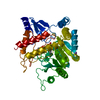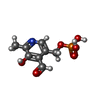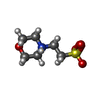[English] 日本語
 Yorodumi
Yorodumi- PDB-1dge: AN ALKALI METAL ION SIZE-DEPENDENT SWITCH IN THE ACTIVE SITE STRU... -
+ Open data
Open data
- Basic information
Basic information
| Entry | Database: PDB / ID: 1dge | ||||||
|---|---|---|---|---|---|---|---|
| Title | AN ALKALI METAL ION SIZE-DEPENDENT SWITCH IN THE ACTIVE SITE STRUCTURE OF DIALKYLGLYCINE DECARBOXYLASE | ||||||
 Components Components | DIALKYLGLYCINE DECARBOXYLASE | ||||||
 Keywords Keywords | LYASE | ||||||
| Function / homology |  Function and homology information Function and homology information2,2-dialkylglycine decarboxylase (pyruvate) / 2,2-dialkylglycine decarboxylase (pyruvate) activity / transaminase activity / pyridoxal phosphate binding Similarity search - Function | ||||||
| Biological species |  Burkholderia cepacia (bacteria) Burkholderia cepacia (bacteria) | ||||||
| Method |  X-RAY DIFFRACTION / Resolution: 2.8 Å X-RAY DIFFRACTION / Resolution: 2.8 Å | ||||||
 Authors Authors | Hohenester, E. / Jansonius, J.N. | ||||||
 Citation Citation |  Journal: Biochemistry / Year: 1994 Journal: Biochemistry / Year: 1994Title: An alkali metal ion size-dependent switch in the active site structure of dialkylglycine decarboxylase. Authors: Hohenester, E. / Keller, J.W. / Jansonius, J.N. #1:  Journal: Science / Year: 1993 Journal: Science / Year: 1993Title: Dialkylglycine Decarboxylase Structure: Bifunctional Active Site and Alkali Metal Sites Authors: Toney, M.D. / Hohenester, E. / Jacob, S.W. / Jansonius, J.N. #2:  Journal: J.Biol.Chem. / Year: 1990 Journal: J.Biol.Chem. / Year: 1990Title: Pseudomonas Cepacia 2,2-Dialkylglycine Decarboxylase. Sequence and Expression in Escherichia Coli of Structural and Repressor Genes Authors: Keller, J.W. / Baurick, K.B. / Rutt, G.C. / O'Malley, M.V. / Sonafrank, N.L. / Reynolds, R. / Ebbesson, L.O. / Vajdos, F.F. | ||||||
| History |
|
- Structure visualization
Structure visualization
| Structure viewer | Molecule:  Molmil Molmil Jmol/JSmol Jmol/JSmol |
|---|
- Downloads & links
Downloads & links
- Download
Download
| PDBx/mmCIF format |  1dge.cif.gz 1dge.cif.gz | 98.9 KB | Display |  PDBx/mmCIF format PDBx/mmCIF format |
|---|---|---|---|---|
| PDB format |  pdb1dge.ent.gz pdb1dge.ent.gz | 73.8 KB | Display |  PDB format PDB format |
| PDBx/mmJSON format |  1dge.json.gz 1dge.json.gz | Tree view |  PDBx/mmJSON format PDBx/mmJSON format | |
| Others |  Other downloads Other downloads |
-Validation report
| Summary document |  1dge_validation.pdf.gz 1dge_validation.pdf.gz | 401 KB | Display |  wwPDB validaton report wwPDB validaton report |
|---|---|---|---|---|
| Full document |  1dge_full_validation.pdf.gz 1dge_full_validation.pdf.gz | 419.4 KB | Display | |
| Data in XML |  1dge_validation.xml.gz 1dge_validation.xml.gz | 12.2 KB | Display | |
| Data in CIF |  1dge_validation.cif.gz 1dge_validation.cif.gz | 18.5 KB | Display | |
| Arichive directory |  https://data.pdbj.org/pub/pdb/validation_reports/dg/1dge https://data.pdbj.org/pub/pdb/validation_reports/dg/1dge ftp://data.pdbj.org/pub/pdb/validation_reports/dg/1dge ftp://data.pdbj.org/pub/pdb/validation_reports/dg/1dge | HTTPS FTP |
-Related structure data
- Links
Links
- Assembly
Assembly
| Deposited unit | 
| ||||||||
|---|---|---|---|---|---|---|---|---|---|
| 1 | 
| ||||||||
| 2 | 
| ||||||||
| Unit cell |
| ||||||||
| Atom site foot note | 1: ATOMS WITH WEAK DENSITY HAVE BEEN REFINED WITH ZERO WEIGHT. 2: LYS 272 IS COVALENTLY BOUND TO THE COFACTOR PLP. | ||||||||
| Details | THE MOLECULE IS A TETRAMER OF IDENTICAL SUBUNITS. THIS ENTRY CONTAINS THE CRYSTALLOGRAPHIC ASYMMETRIC UNIT WHICH COMPRISES ONE MONOMER. THE TETRAMER CAN BE GENERATED BY CRYSTALLOGRAPHIC DYADS. APPLYING THE FOLLOWING TRANSFORMATION TO THE COORDINATES IN THIS ENTRY WILL YIELD A DIMER: MTRIX1 1 -0.500000 0.866000 0.000000 0.00000 MTRIX2 1 0.866000 0.500000 0.000000 0.00000 MTRIX3 1 0.000000 0.000000 1.000000 28.87000 APPLYING THE FOLLOWING TRANSFORMATION TO THE DIMER WILL YIELD THE TETRAMER: MTRIX1 2 -1.000000 0.000000 0.000000 76.40000 MTRIX2 2 0.000000 -1.000000 0.000000 132.20000 MTRIX3 2 0.000000 0.000000 1.000000 0.00000 |
- Components
Components
| #1: Protein | Mass: 46374.145 Da / Num. of mol.: 1 Source method: isolated from a genetically manipulated source Source: (gene. exp.)  Burkholderia cepacia (bacteria) Burkholderia cepacia (bacteria)References: UniProt: P16932, 2,2-dialkylglycine decarboxylase (pyruvate) | ||||||||||
|---|---|---|---|---|---|---|---|---|---|---|---|
| #2: Chemical | | #3: Chemical | ChemComp-PLP / | #4: Chemical | ChemComp-MES / | #5: Water | ChemComp-HOH / | Has protein modification | N | Sequence details | SEQUENCE ADVISORY NOTICE DIFFERENCE BETWEEN SWISS-PROT AND PDB SEQUENCE. SWISS-PROT ENTRY NAME: ...SEQUENCE ADVISORY NOTICE DIFFERENCE | |
-Experimental details
-Experiment
| Experiment | Method:  X-RAY DIFFRACTION X-RAY DIFFRACTION |
|---|
- Sample preparation
Sample preparation
| Crystal | Density Matthews: 3.17 Å3/Da / Density % sol: 61.25 % | ||||||||||||||||||||||||||||||||||||||||||||||||||||||||||||
|---|---|---|---|---|---|---|---|---|---|---|---|---|---|---|---|---|---|---|---|---|---|---|---|---|---|---|---|---|---|---|---|---|---|---|---|---|---|---|---|---|---|---|---|---|---|---|---|---|---|---|---|---|---|---|---|---|---|---|---|---|---|
| Crystal grow | *PLUS pH: 7.5 / Method: vapor diffusion, hanging drop / Details: referred to J.Mol.Biol. 222.873-875 1991 | ||||||||||||||||||||||||||||||||||||||||||||||||||||||||||||
| Components of the solutions | *PLUS
|
-Data collection
| Radiation | Scattering type: x-ray |
|---|---|
| Radiation wavelength | Relative weight: 1 |
| Reflection | *PLUS Highest resolution: 2.8 Å / Num. obs: 14856 / % possible obs: 97.7 % / Num. measured all: 62340 / Rmerge(I) obs: 0.108 |
- Processing
Processing
| Software | Name: TNT / Classification: refinement | ||||||||||||||||||||||||||||||
|---|---|---|---|---|---|---|---|---|---|---|---|---|---|---|---|---|---|---|---|---|---|---|---|---|---|---|---|---|---|---|---|
| Refinement | Resolution: 2.8→8 Å / σ(F): 0 /
| ||||||||||||||||||||||||||||||
| Refinement step | Cycle: LAST / Resolution: 2.8→8 Å
| ||||||||||||||||||||||||||||||
| Refine LS restraints |
| ||||||||||||||||||||||||||||||
| Software | *PLUS Name: TNT / Classification: refinement | ||||||||||||||||||||||||||||||
| Refinement | *PLUS Rfactor obs: 0.195 | ||||||||||||||||||||||||||||||
| Solvent computation | *PLUS | ||||||||||||||||||||||||||||||
| Displacement parameters | *PLUS | ||||||||||||||||||||||||||||||
| Refine LS restraints | *PLUS
|
 Movie
Movie Controller
Controller













 PDBj
PDBj







